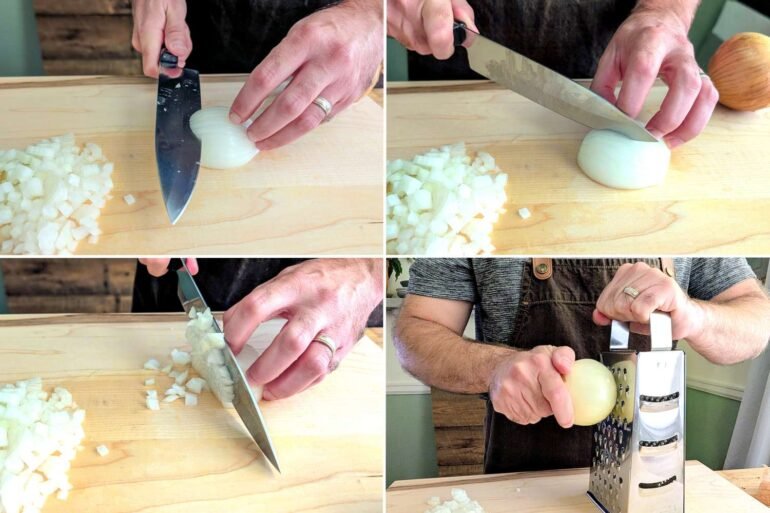:max_bytes(150000):strip_icc():format(jpeg)/How-Chefs-Cut-an-Onion-FT-BLOG0925-09f48fa9e900408d8e047e00e58f0d37.jpg)
Whether they play a supporting or starring role, onions are the all-purpose flavor agent of the kitchen. They can be bold when sliced thin and served raw as a burger topping, or silky and sweet when julienned and slowly caramelized. Just as there are countless ways to serve the ubiquitous vegetable, there are a lot of different ways to prep an onion.
We reached out to a handful of chefs from across the country to learn the techniques they rely upon for cutting onions at home. Here are the easy-to-follow methods they recommend to make the task a breeze.
Start by peeling
Before cutting the onion, all the chefs suggest peeling it first. This step may seem obvious, but it gives you more control than if you cut through the papery peel.
“How I cut an onion depends on the type of onion that I’m working with and the application,” explains Matthew Niessner, corporate executive chef of Halls Chophouse, with locations in South Carolina and Nashville. “Typically, I start by cutting off the root end and the top end, creating flat surfaces. Then, I put a very slight incision in the peel, which allows me to peel the outer layer without cutting into the onion.”
Once you have a peeled onion, you can move on to cutting it into your desired shapes and sizes.
The classic method
You’ve likely seen this technique if you’ve ever watched a celebrity chef dice an onion. It was the method my very French chef-instructor from culinary school hammered into us in our first few weeks — and it’s classic for a reason.
How to do it
“I still stick with the traditional method I learned in culinary school,” says Greg Garrison, chef and partner of Repeal 33 in Savannah, Georgia. “I’ll cut the onion in half, lay it flat, and slice into it horizontally first. Then I go vertically down from the top. The key is holding the onion steady on the sides with your fingers tucked in, and using a clean slicing motion with a sharp knife. After that, cutting across gives you a quick, even dice every time. Simple, efficient, and always consistent.”
This basic technique works well for chopping onions or dicing them into cubes. You can also get a finer dice with thinner slices. “If I want to brunoise (a very fine dice), I will leave the stem on and do very thin cuts from the root to the base and then make some thin cuts horizontally, and then slice my knife vertically” through the small cubes, explains Manuela Carbone, executive chef of Florería Atlántico and Brasero Atlántico in Washington, D.C.
You can also get thin slices like a julienne (matchstick) cut by following this technique. “If I need a julienne, I will cut off the root and make thin cuts [following the lines] of the onion,” Carbone says.
This technique means you won’t have to over-chop the onion, which could make for a harsher sulfur flavor and watery texture.
Pro tips
- Minimize the risk of harming yourself by ensuring your cutting board is firmly in place. “The most important rule for cutting an onion is a stable cutting board,” Carbone says. “If your cutting board is not stable, you can get a small rubber mat (or a wet piece of paper) and place it under your cutting board.” A wet towel will also do the trick.
- “Always grab the onion as if you had a claw in your hand,” Carbone recommends. “Fingertips bended to the inside.” Curling your fingers into a claw shape will nearly eliminate the chances of the knife slipping and slicing through your fingers, as they’re tucked away instead of exposed.
Using a mandoline
annick vanderschelden photography / Getty Images
If you are looking for more precision or very consistent slices, consider using a mandoline. Whether using a thin Japanese or larger French mandoline slicer, you can easily adjust the thickness depending on your intended use. This tool will produce exceptionally consistent slices of onion that you can use as is or slice further for a tiny brunoise cut. “This is a simple and effective technique we do daily at Counter Service for use in our most popular sandwiches,” says Andrew Black, chief culinary officer of the New York City sandwich shop with three locations.
How to do it
Be sure to protect your fingers with a guard or even a cut-resistant glove, as the blade on a mandoline is very sharp. Set up your mandoline on a sturdy base like a cutting board, then adjust the blade to your desired thickness. A standard brunoise is about 1/8-inch thick, while a fine brunoise is 1/16-inch thick. Choose a thicker setting if you want slices for onion rings or you plan to make half-moon strips.
Similar to the classic technique, be sure to peel the onion first and trim a bit off the opposite end from the stem to create a flat surface. Cut it in half if you want to make half moon slices or a fine dice. If you want rings, leave the onion whole. Regardless, be sure to leave the root on the onion to hold the vegetable together and give yourself something to grip.
“I do use the classic culinary technique for most dicing, but when I want a really fine dice, I will slice the onion as thinly as possible on the meat slicer or mandoline, then stack the slices and chop into a fine dice,” says Karin Feeny Farrell, chef and co-owner or Kitchen Sync in Greenville and Greer, South Carolina.
Shredding with a box grater
Adam Dolge
If you want to reduce some of the moisture from the onion and have it blend easily into other ingredients, chefs recommend turning to a very common kitchen tool. “Box shredders (graters) are great for shredding onions,” Niessner says. “Shredded onions are perfect for applications when you need the flavor of onion, but do not want to detect the texture. I use this method for potato pancakes and latkes.”
How to do it
Like the other methods, peel and prep the onion so the stem is still intact but the opposite end is flat. For particularly large onions, like Vidalia, consider cutting in half. Medium and small onions can be left whole. Set the box grater on a sturdy cutting board and grip the onion by the stem end. Carefully run the trimmed end of the onion along the large holes of the grater and apply gentle pressure. Let the grater do most of the work, but hold the onion tightly so it doesn’t slip from your grip.
Once you finish grating, you’ll have a pile of finely shredded, watery onions. You will typically want to use a clean kitchen towel to squeeze out some, or most, of the excess water. Regardless, the shredded onion is now ready to be mixed into a variety of dishes. “For my pimiento cheese and potato salad, I use the large holes on a cheese grater,” Farrell says.
Pro tips
- Cutting raw onions can make your eyes water thanks to naturally occurring sulfur compounds. “Chill onions to reduce tears,” recommends Zachary Chancey, executive chef of The Alida, a hotel in Savannah, Georgia.
- Tame the harsh raw flavor by giving the onions a rinse under cold water. “Rinsing the onions reduces the pungent sharpness while enhancing their fresh, crisp bite,” Black says. “Perfect for people who claim they don’t like raw onions.”
Adam Dolge
2025-09-30 13:30:00

